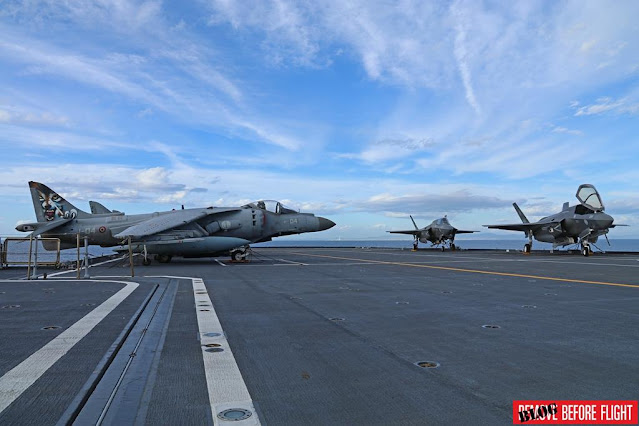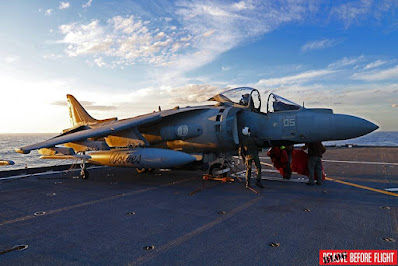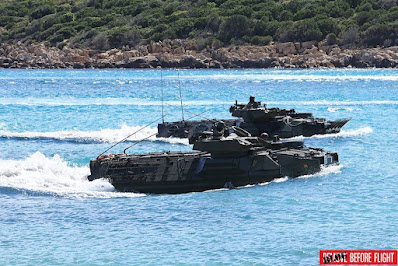Italian Navy Mare Aperto 2023-1 exercise
 |
| Italian Navy F-35B aircraft takes off from the flight deck of the ITS Cavour aircraft carrier. |
The Italian Navy-led exercise Mare Aperto 2023-1 is run in the seas surrounding southern Italy from 13 April to 6 May. The Mare Aperto is a high-end joint, combined, multi-domain and multi-threat exercise which takes place every year in one or two sessions. Over the course of the three-week exercise, over 5,500 soldiers from 23 nations (13 NATO countries and 10 Partners), 41 naval units (including submarines), aircraft and helicopters, amphibious units of the San Marco Brigade, commandos and divers of the COMSUBIN operated between the Adriatic Sea, the Ionian Sea, the Tyrrhenian Sea, the Strait of Sicily and the Sea of Sardinia, including the coastal areas, the neighboring territories and the related airspaces. The activities also involved personnel, aircraft and vehicles of the Coast Guard, the Italian Army , Italian Air Force, Carabinieri and Guardia di Finanza.
The Italian Air Force participated with various aircraft including Eurofighter and F-35B STOVL fighters, CAEW G550 command and control aircraft and KC-767A tanker aircraft. As evidence of the great integration between the Italian armed forces, the ITAF F-35B operated from the Cavour aircraft carrier together with the ITN F-35B and AV-8B Harrier II Plus aircraft.
“The F-35 of the Air Force is integrated on board like those of the Navy, the pilots and specialists of the Air Force are able to operate on board like ours. The Navy team has the advantage of a longer experience at sea, but over time the Air Force specialists are increasingly progressing and we are aiming for an exchange of experience, information and anything that can help each other grow the best capacity,” said Vessel Captain Enrico Vignola, Commander of the Cavour aircraft carrier.
The Italian Air Force participated with various aircraft including Eurofighter and F-35B STOVL fighters, CAEW G550 command and control aircraft and KC-767A tanker aircraft. As evidence of the great integration between the Italian armed forces, the ITAF F-35B operated from the Cavour aircraft carrier together with the ITN F-35B and AV-8B Harrier II Plus aircraft.
“The F-35 of the Air Force is integrated on board like those of the Navy, the pilots and specialists of the Air Force are able to operate on board like ours. The Navy team has the advantage of a longer experience at sea, but over time the Air Force specialists are increasingly progressing and we are aiming for an exchange of experience, information and anything that can help each other grow the best capacity,” said Vessel Captain Enrico Vignola, Commander of the Cavour aircraft carrier.
The fifth generation F-35B aircraft is the backbone of the fixed-wing component of Italian naval aviation. It has made the Italian Navy take a big leap forward which allows for a greater ability to project forces from the sea and to protect the naval fleet. It is currently operating alongside Harrier jump jets during the transition phase.
“The management of two types of aircraft involves a great logistical effort as it means taking on board an uncommon support for both lines and therefore spare parts, equipment needed to make the aircraft work, but above all maintenance teams who are dedicated to each line even if our specialists are partially able to intervene on both. We aim to qualify personnel in the most flexible and redundant way possible, especially now that we are in a transition phase. The presence of two lines also requires a diversification of operational tactics. Right now we have 3 Navy F-35Bs plus one Air Force and 4 Navy AV-8s,” said Commander Vignola.
The diversified and realistic scenario of the MA23-1 focused on carrying out an operation which envisaged the use of a multinational force made up of various naval groups, characterized by a strong expeditionary connotation, with the involvement of air, land and submarine assets.
“The aircraft carrier has a central role in the maritime force because it allows us to support the acquisition of sea control and air superiority, not only on the sea, but also in the adjacent land area where we employ the landing force. The landing force is one of the elements of the amphibious force which consists of the amphibious ships with landing craft, with embarked helicopters and in the concept of amphibious operation the air support which is provided by the aircraft carrier is fundamental,” said Admiral Aurelio De Carolis, Italian Navy Chief of the Fleet.
The deployed units were led by the staff of the various Naval Divisions, the San Marco Brigade and the Commands of the Specialized Components of the Navy. They have ventured into highly realistic simulations, the fight against conventional and asymmetrical threats, raids on coastal sites of interest, maritime security exercises, seabed control and remediation, prevention and combating of illicit trafficking. As part of the dual tasks of the Italian Navy, the units also carried out activities to protect the maritime environment and rescue populations affected by natural disasters with the collaboration of Civil Protection personnel.
MA23-1 took place over a very large area of 500,000 square miles to allow the Navy to train in moving forces, i.e. planning, executing and reviewing plans on a daily basis.
According to Admiral De Carolis, the scenario envisaged that Enotria, a NATO country with a fictitious name, had to intervene together with other Partner countries, under a United Nations directive, to resolve an internal situation of instability caused by terrorist groups. These terrorists were supported by another country with good war potential, with the fictitious name Arethusa, which frowned upon the intrusion of other nations. This scenario continues the one started with the last exercise, this allows them to evolve what they did previously rather than start from scratch.
As in the previous sessions of the exercise, about 70 university students were embarked on the ships divided into the team of “good” and “bad” guys who had the task of providing information or disinformation that influenced the choices of commanders and operations.
👉 You may also like: Visit to Naval Air Station - NAS Luni, an Italian Navy's state-of-the-art air station
Report by Matteo Sanzani

























No comments
All comments related to the contents of our articles are welcome. It is not allowed to post promotional messages, links to external sites, or references to activities not related to this blog.